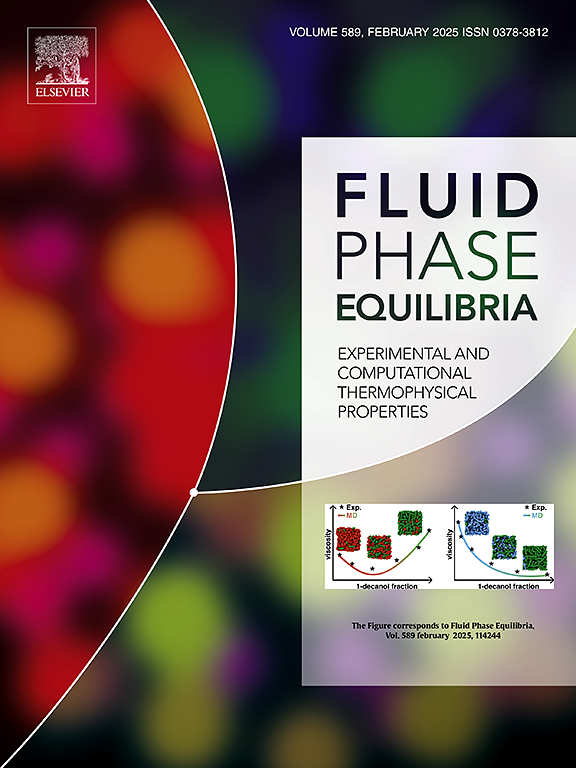Thermodynamic modeling CO2 absorption in semi-aqueous monoethanolamine with N-methyl-2-pyrrolidone using electrolyte NRTL model
IF 2.7
3区 工程技术
Q3 CHEMISTRY, PHYSICAL
引用次数: 0
Abstract
Partially replacing water with N-methyl-2-pyrrolidone (NMP) in aqueous monoethanolamine (MEA) solutions has been shown to reduce the energy demand of CO2 capture. However, the absence of rigorous thermodynamic models for semi-aqueous MEA-NMP solvents hinders process design and optimization. This study develops a thermodynamic model for CO₂ absorption in NMP–H2O–MEA–CO2 mixtures using the electrolyte NRTL framework. The model extends the established H2O–MEA–CO2 system by incorporating NMP-specific parameters while preserving accuracy in the aqueous regime. A sequential regression approach is applied to correlate key properties relevant to CO2 capture, including CO₂ solubility, excess enthalpy, heat of absorption, and liquid heat capacity across binary to quaternary systems. Viscosity and density are also modeled to support mass transfer calculations. To improve model accuracy, new CO2 solubility data are measured for NMP–H₂O–MEA–CO2 mixtures at 313–393 K. The model accurately represents CO2 solubility across a wide range of CO2 loadings, temperatures, and NMP contents, revealing a decrease in solubility and a 10–25 kJ/mol CO2 increase in heat of absorption with NMP addition. The developed model enables rigorous process simulation and facilitates the design of energy-efficient CO2 capture using semi-aqueous MEA-NMP solvents.
利用电解质NRTL模型模拟n -甲基-2-吡咯烷酮在半水单乙醇胺中的CO2吸收
在单乙醇胺(MEA)水溶液中用n -甲基-2-吡咯烷酮(NMP)部分取代水已被证明可以减少二氧化碳捕获的能源需求。然而,缺乏严格的半水MEA-NMP溶剂热力学模型阻碍了工艺设计和优化。本研究利用电解质NRTL框架建立了NMP-H2O-MEA-CO2混合物中CO₂吸收的热力学模型。该模型通过纳入nmp特异性参数扩展了已建立的H2O-MEA-CO2系统,同时保持了水态的准确性。序列回归方法应用于关联与CO2捕获相关的关键特性,包括CO2溶解度、过剩焓、吸收热和跨二元到四元体系的液体热容。粘度和密度也建模,以支持传质计算。为了提高模型精度,在313-393 K下测量了NMP-H₂- mea - CO2混合物的新的CO2溶解度数据。该模型准确地代表了二氧化碳在广泛的二氧化碳负荷、温度和NMP含量范围内的溶解度,揭示了加入NMP后,二氧化碳的溶解度降低,吸收热增加10-25 kJ/mol。开发的模型能够进行严格的过程模拟,并促进使用半水MEA-NMP溶剂的节能CO2捕获设计。
本文章由计算机程序翻译,如有差异,请以英文原文为准。
求助全文
约1分钟内获得全文
求助全文
来源期刊

Fluid Phase Equilibria
工程技术-工程:化工
CiteScore
5.30
自引率
15.40%
发文量
223
审稿时长
53 days
期刊介绍:
Fluid Phase Equilibria publishes high-quality papers dealing with experimental, theoretical, and applied research related to equilibrium and transport properties of fluids, solids, and interfaces. Subjects of interest include physical/phase and chemical equilibria; equilibrium and nonequilibrium thermophysical properties; fundamental thermodynamic relations; and stability. The systems central to the journal include pure substances and mixtures of organic and inorganic materials, including polymers, biochemicals, and surfactants with sufficient characterization of composition and purity for the results to be reproduced. Alloys are of interest only when thermodynamic studies are included, purely material studies will not be considered. In all cases, authors are expected to provide physical or chemical interpretations of the results.
Experimental research can include measurements under all conditions of temperature, pressure, and composition, including critical and supercritical. Measurements are to be associated with systems and conditions of fundamental or applied interest, and may not be only a collection of routine data, such as physical property or solubility measurements at limited pressures and temperatures close to ambient, or surfactant studies focussed strictly on micellisation or micelle structure. Papers reporting common data must be accompanied by new physical insights and/or contemporary or new theory or techniques.
 求助内容:
求助内容: 应助结果提醒方式:
应助结果提醒方式:


